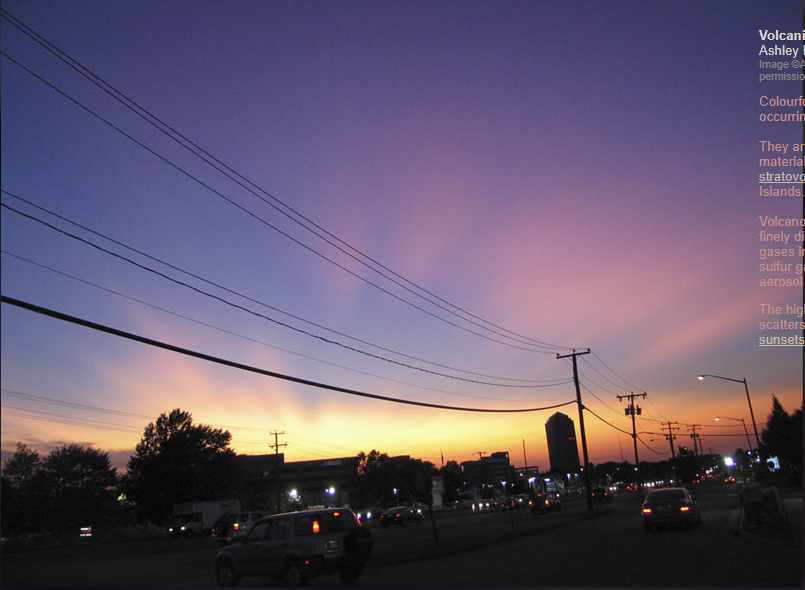Volcanic Twilight
Volcanic Twilight: Exploring the Phenomenon of Colorful Sunsets and Twilights
Have you ever witnessed a breathtaking sunset or twilight that seemed to explode with vibrant colors? These mesmerizing displays of nature's artistry often occur over the United States, captivating onlookers with their beauty. But what causes these enchanting phenomena? It turns out that the eruptions of stratovolcanoes in the Aleutian Islands may hold the key to understanding this atmospheric spectacle.
Stratovolcanoes, such as those found in the Aleutian Islands, have the power to propel massive amounts of finely divided ash and sulfur oxide gases into the stratosphere during eruptions. As these volcanic materials ascend to higher altitudes, they undergo a transformation. The sulfur gases emitted by the volcanoes react with other elements in the atmosphere, ultimately producing aerosol particles.
These aerosol particles play a crucial role in the creation of colorful sunsets and twilights. When sunlight encounters these high-altitude dust and aerosol particles, it scatters in various directions, resulting in a scattering phenomenon known as Rayleigh scattering. This scattering process selectively scatters shorter wavelengths of light, such as blue and green, while allowing longer wavelengths, such as red and orange, to pass through more easily. The result is a stunning display of vibrant hues that adorn the sky during twilight hours.
The scattering of sunlight by volcanic aerosols can produce a range of captivating optical effects. One such phenomenon is the appearance of glorious sunsets, where the sky is transformed into a canvas painted with hues of gold, pink, purple, and orange. These captivating displays can evoke a sense of awe and wonder, leaving observers spellbound by the ethereal beauty unfolding before their eyes.
In addition to vibrant sunsets, volcanic aerosols can also give rise to other optical phenomena. Rays, also known as crepuscular rays or sunbeams, are often observed during volcanic twilights. These rays appear as beams of light radiating from the horizon and extending towards the zenith. They are caused by the scattering of sunlight by the aerosol particles present in the atmosphere. As sunlight interacts with these particles, it creates a visual spectacle reminiscent of celestial spotlights piercing through the clouds.
Another fascinating optical effect associated with volcanic twilights is the appearance of Bishop's rings. These rings, also known as the Bishop's halo or the 22° halo, encircle the sun or moon and exhibit a circular shape with a radius of approximately 22 degrees. The formation of Bishop's rings involves the refraction and reflection of sunlight or moonlight by ice crystals present in the atmosphere. These ice crystals can be introduced into the upper atmosphere during volcanic eruptions, providing the necessary conditions for the formation of this captivating phenomenon.
While volcanic twilight events can create breathtaking displays in the sky, it is important to note that they are temporary in nature. The presence of volcanic aerosols in the stratosphere is transient, and their effects on atmospheric optics may gradually diminish over time as the particles disperse or settle back to lower altitudes. Therefore, capturing and cherishing these fleeting moments of natural beauty becomes even more special.
In conclusion, the occurrence of colorful sunsets and twilights over the United States can be attributed to the eruptions of stratovolcanoes in the Aleutian Islands. The lofting of ash and sulfur oxide gases into the stratosphere leads to the production of aerosol particles, which scatter sunlight and give rise to vibrant displays of color. From glorious sunsets to rays and Bishop's rings, these atmospheric phenomena remind us of the awe-inspiring power of nature and its ability to paint the sky with hues that leave us captivated and inspired. So, keep your eyes peeled and embrace the magic of volcanic twilight whenever it graces the heavens above.

Volcanic Twilight Sky imaged by Ashley Bradford August 20, '08. Image ©Ashley Bradford, shown with permission.
Colourful sunsets and twilights are occurring over the United States.
They are probably caused by material from the eruptions of three stratovolcanoes in the Aleutian Islands.
Volcanoes loft vast tonnages of finely divided ash and sulfur oxide gases into the stratosphere. The sulfur gases subsequently produce aerosol particles.
The high altitude dust and aerosol scatters sunlight to give glorious sunsets, rays and Bishop's rings.
Note: this article has been automatically converted from the old site and may not appear as intended. You can find the original article here.
Reference Atmospheric Optics
If you use any of the definitions, information, or data presented on Atmospheric Optics, please copy the link or reference below to properly credit us as the reference source. Thank you!
-
<a href="https://atoptics.co.uk/blog/volcanic-twilight-2/">Volcanic Twilight</a>
-
"Volcanic Twilight". Atmospheric Optics. Accessed on December 22, 2024. https://atoptics.co.uk/blog/volcanic-twilight-2/.
-
"Volcanic Twilight". Atmospheric Optics, https://atoptics.co.uk/blog/volcanic-twilight-2/. Accessed 22 December, 2024
-
Volcanic Twilight. Atmospheric Optics. Retrieved from https://atoptics.co.uk/blog/volcanic-twilight-2/.